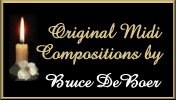 |
Roll the Stone
A Dialog Sermon by the Rev. Lee Woofenden and Eli
Dale
Bridgewater, Massachusetts, March 31, 2002
Easter Sunday

Readings
Matthew 27:57-66 The burial of Jesus
As evening approached, there came a rich
man from Arimathea, named Joseph, who had himself become a disciple of
Jesus. Going to Pilate, he asked for Jesus' body, and Pilate ordered that
it be given to him. Joseph took the body, wrapped it in a clean linen
cloth, and placed it in his own new tomb that he had cut out of the rock.
He rolled a large stone in front of the entrance to the tomb and went
away. Mary Magdalene and the other Mary were sitting there opposite the
tomb.
The next day, the one after Preparation
Day, the chief priests and the Pharisees went to Pilate. "Sir,"
they said, "we remember that while he was still alive that deceiver
said, 'After three days I will rise again.' So give the order for the tomb
to be made secure until the third day. Otherwise, his disciples may come
and steal the body and tell the people that he has been raised from the
dead. This last deception will be worse than the first."
"Take a guard," Pilate
answered. "Go, make the tomb as secure as you know how." So they
went and made the tomb secure by putting a seal on the stone and posting
the guard.
Mark 16:1-3 The women approach the tomb
When the Sabbath was over, Mary
Magdalene, Mary the mother of James, and Salome bought spices so that they
might go to anoint Jesus' body. Very early on the first day of the week,
just after sunrise, they were on their way to the tomb and they asked each
other, "Who will roll the stone away from the entrance of the
tomb?"
Matthew 28:2-20 The Resurrection
And there was a violent earthquake, for
an angel of the Lord came down from heaven and, going to the tomb, rolled
back the stone and sat on it. His appearance was like lightning, and his
clothes were white as snow. The guards were so afraid of him that they
shook and became like dead men.
The angel said to the women, "Do
not be afraid, for I know that you are looking for Jesus, who was
crucified. He is not here; he has risen, just as he said. Come and see the
place where he lay. Then go quickly and tell his disciples: 'He has risen
from the dead and is going ahead of you into Galilee. There you will see
him.' Now I have told you."
So the women hurried away from the tomb,
afraid yet filled with joy, and ran to tell his disciples. Suddenly Jesus
met them. "Greetings," he said. They came to him, clasped his
feet and worshipped him. Then Jesus said to them, "Do not be afraid.
Go and tell my brothers to go to Galilee; there they will see me."
While the women were on their way, some
of the guards went into the city and reported to the chief priests
everything that had happened. When the chief priests had met with the
elders and devised a plan, they gave the soldiers a large sum of money,
telling them, "You are to say, 'His disciples came during the night
and stole him away while we were asleep.' If this report gets to the
governor, we will satisfy him and keep you out of trouble." So the
soldiers took the money and did as they were instructed. And this story
has been widely circulated among the Jews to this very day.
Then the eleven disciples went to
Galilee, to the mountain where Jesus had told them to go. When they saw
him, they worshipped him; but some doubted. Then Jesus came to them and
said, "All power in heaven and on earth has been given to me.
Therefore go and make disciples of all nations, baptizing them in the name
of the Father and of the Son and of the Holy Spirit, and teaching them to
obey everything I have commanded you. And surely I am with you always, to
the very end of the age."
Apocalypse Explained #400.14 The stone and the earthquake
The great earthquake that took place
when the angel came down from heaven and rolled back the stone from the
mouth of the tomb means that the state of the church was entirely changed.
For the Lord then rose again, and in his human nature took upon himself
all power over heaven and earth, as he himself says (in Matthew 28:18).
The angel rolling away the stone from
the mouth of the tomb and sitting on it means that the Lord pushed aside
all the false beliefs that had blocked access to him, and opened up the
access to divine truth.
The stone symbolizes the divine truth
that the [ancient] Jews had falsified by their traditions--for it says
that the chief priests and Pharisees sealed the stone with a guard
(Matthew 27:66), but that an angel from heaven rolled it back, and sat on
it (Matthew 28:2).

Sermon
And there was a violent earthquake,
for an angel of the Lord came down from heaven and, going to the tomb,
rolled back the stone and sat on it. (Matthew 28:2)
Lee: Easter is a day of change. Huge
change. Yes, the birth of Jesus Christ that we celebrate every year at
Christmas time was the turning point in our world's spiritual history.
Even our calendar bears witness to this, with its years numbered from the
date of Christ's birth. But it was the event of Easter--the resurrection
of Jesus Christ--that originally changed our Lord's followers from a
scattered, disheartened bunch of emotionally crushed and grieving people
into an energized, focused, and spirit-filled community of faith that
would go out with zeal to spread the Good News, building the human
foundations for the Christian Church.
In the spirit of change, today Eli and I
are going to offer our Easter Sunday message as a conversation between the
two of us. We invite you to listen in as we share our thoughts on the huge
change that Easter represents. And especially, this Easter we are going to
focus on that big old rock that was rolled in front of the Lord's tomb,
and then rolled away on the first Easter Sunday.
It may seem funny to preach about a rock
on Easter Sunday. After all, isn't Easter about the Lord's resurrection?
But that rock is what the people who were opposed to Jesus thought would
seal his fate forever, and put to rest all those wild predictions that he
would rise again after three days. And spiritually, our church's teachings
say that the rock over the entrance to the Lord's tomb symbolizes all the
false ideas, both in the surrounding culture and in us individually, that
block our access to the Lord. Eli, perhaps you have more thoughts on what
this stone means, and how it got there?
Eli: Oh, Lee, there are so many ways that we block our access to
the Lord--all of them effective! As you say, the stone belongs both to the
greater culture and to each of us individually. In the Crucifixion story,
we see a culture-wide rejection of good and truth which leads to a
horrific injustice. When the ruling powers want to set a seal on the stone
that is rolled across the entrance to the tomb, it is as if they are
trying to pull the wool over the people's eyes. "There is no cause
for alarm. All danger is contained. Everything is normal. It was all that
guy's fault, but we got him." This story is very real, very present,
very much about us, but because it seems to be about ancient people
long ago and far away, it can be hard to relate to. And because it seems
to be about corrupt power structures, it can be hard to feel empowered to
do anything about it. It is tempting for us to fail to see how this
story of injustice and scapegoating, this story of business as usual, this
story of powerlessness in the face of angry, frightened power-holders is
alive and well today, in many nations, including our own.
Yet, we cannot dust off our hands and
say, "Oh well, what do you expect me to do? It's the government's
fault and you can't get them." That stone comes in all shapes and
sizes, including personal sized. Each of us gets ample opportunity to put
our own interests ahead of someone else's, to protect our own needs and
power, and thereby roll that stone between us and heaven. Whenever I say,
"Oh I suppose I should write that note card or make that phone call,
but maybe I'll do it tomorrow" (and I can say that for weeks on
end!), I put a stone between myself and divine guidance. Whenever I say,
"Oh, everyone else does it [fill in your favorite bad habit]; it
can't be all that bad"; whenever I say, "Oh, there's that street
person pan handling again, I'd better cross to the other side"; even
when I say, "Oh, I can have another piece of cheesecake," I am
blocking the light!
Where does that stone come from? Fear, I
think. Fear that I might not get enough, fear that I might lose status,
fear that I might have to face myself and not like what I find there.
Lee: Hmm. Fear. I hate to say it, but you just stepped right
into the middle of one of those debates that goes on in my head, and, I
think, in our society generally. (Maybe you knew that. . . .)
What keeps us--as individuals, as a society, as a world--from living up to
the wonderful potentials that God created us for? What keeps us involved
in conflicts and wars, in self-defeating habit patterns and malfunctioning
relationships? The answer of today's enlightened psychology is that it is
our fear and pain that keeps us down.
Traditional Christianity rejects that
notion, saying instead that it is sin that keeps us down. Or to put
it in somewhat less charged language, it is our desire for personal power,
material possessions, and physical pleasures--and in particular, our
willingness to put these ahead of love for God and love for our fellow
human beings--that is the "stone" covering the entrance to the
tomb, keeping the Lord's potential presence in our lives safely dead and
buried.
The "fear and pain" theory
emphasizes what we have suffered and do suffer--what is done to us.
The "selfishness, materialism, and sin" theory emphasizes our
own complicity in the wrongs of the world--what we do to others and
to ourselves.
What strikes me now is that both
of these are present in the story of that stone blocking the entrance to
the tomb. It was materialism and grasping for power on the part of the
ruling powers that put the stone over the tomb, and placed the guards that
were meant to keep it there. And when the earthquake struck, both the
guards, on the one hand, and the women coming to tend to the Lord's body,
on the other, were struck with fear.
Eli: Well, I'm glad you brought the
"pain" part of the issue into the discussion, even if you don't
think it is the "right answer." Personal pain may express itself
as fear. I don't think we would tend to be so materialistic and selfish if
it weren't for fear. Sometimes that fear is buried very deep. After all,
if you have a big enough house, why get a bigger one? If you have enough
furniture, why get more furniture? If you ask, "Don't you already
have enough?" the answer may look self centered: "I want it and
I can afford it, so why not?" Those of us who don't have even-bigger
houses can get self-righteous and label that "plain old selfishness
driven by plain old selfishness"--i.e., "sin." But if you
try to take any sized house or any amount of furniture away from a person,
I think the reaction you would get is fear. Most Americans have far more
than we need and far more than most other people in the world, but we
would be afraid to lose it.
Maybe we shouldn't differentiate sin and
fear. Maybe being afraid is a sin. One of heaven's favorite greetings to
us earth-beings is, "Be not afraid." Maybe that is the basis of
repentance!
But personal pain also expresses itself
in despair, and this too is a major block to heaven's light. I remember
one Easter when I was a kid and we were having an Easter egg hunt. One of
the children had not found any eggs. When the rest of us became aware of
that, we tried to trick her into finding eggs, so she would be successful.
Yes, I know that is codependent, but we wanted to bring her into the fun.
So we would lure her over to where we could see an egg and try to get her
to find it, but she was in such despair by that time that she couldn't (or
wouldn't) find the eggs she was tripping over.
I don't see too much wrong with the
modern model of "fear and pain" as blocks to God. Not all fear
and pain is done "to" us by some other agent. We can do them to
ourselves as well. Jesus told his disciples he would be killed and he was.
He also told them that he would rise again. But they didn't believe him.
Their disbelief was the result of having greater faith in their despair
than in his promise. That stone separated both friends and Pharisees from
the Lord.
Lee: I think we're heading toward some of the same conclusions, but
from different directions. It is not that I think the modern fear and pain
model is the "wrong answer," but that it is not the whole
answer. More to the point, fear and pain are one side of the coin, while
selfishness, materialism, and sin are the other.
Whether someone is doing it to us, we're
doing it to them, or we're doing it to ourselves, what it amounts to is
that we get off track--and that seals the Lord in the tomb within us and
among us. All of these things block out the Lord's presence. This
makes us less human than we could be, and our relationships more broken
than they need to be.
But what is amazing about the Easter
story is that the stone doesn't stay over the entrance of the tomb.
Here we all are, each of us caught up in our own favorite mode of falling
short of the glory of God. Some of us are into fear and pain. Some of us
are into sin. Some of us are into guilt, or depression. And some of us
come up with other ways to keep the Lord dead and buried.
What I love about the story of the women
approaching the tomb early Sunday morning is that they were asking,
"Who will roll the stone away from the entrance to the tomb."
They knew they couldn't do it. And yet they went anyway. Even when they
believed that their Lord was dead, and weren't sure they would be able to
do anything at all, they approached that place of deadness where they felt
he was.
But they didn't find him dead. The stone
was already rolled away by an angel of God. They had no use for the spices
they brought with them to anoint a dead body. Instead, they encountered
the risen, living Jesus, and found themselves clasping his feet in fear
and joy all mixed together.
And if, on a deeper level, the Bible
story is our story, then this must mean that our particular
"stone" can be rolled away, too.
Eli: There are two interesting points to that part of the story.
The first is that the women turned their wills to do the right thing: they
turned toward heaven's light, to embrace the good. Even without having the
vaguest idea how they could accomplish their goal, they set out to
do it because it was the right thing to do. Swedenborg tells us that this
is exactly how life works. Act as if you are the one who is acting and the
Lord, who is the good you are trying to do, will flow into the
matter. It looks like your work, but it turns out to be the Lord's work.
Of course the stone will be rolled away, and not by us, just as soon as we
"intend and do" that which is good and true. No matter how big a
mess we have made of our lives, if we dive deeper into ourselves, into our
"God place" where the Lord always dwells, new heavenly energy
will open up our lives, rolling the stone away.
When I signed up to go to seminary, I
didn't have any idea how I would pay for it. I signed up for classes
anyway. One day I was praying to God to help me find the money only for
the coming semester. Then I went about my life and started cleaning out
some old files. In those files I discovered a US Savings Bond I didn't
even know I had. My mother had given it to me years before and I filed it,
knowing I had to wait several years before I paid it any mind. I asked God
to help me find the money and I literally found it!
The second interesting part of the story
is this: reality was different than the women thought it would be and they
had to make a new plan. They went to anoint their dead and instead they
found life. This is the kind of surprise which can inspire us to put the
stone back over the tomb because we're not getting "our way" or
because we don't recognize this new reality and think that God has not
answered our prayers. But it is the Lord's will we seek to be done. It's
obvious in this story, but in our lives it isn't always so obvious.
Lee: Aha! So our response to the change is just as important
as the change itself! Like the little girl in your Sunday School who
couldn't find the Easter eggs even when she was tripping over them, the
stone could be rolled away, and we could have a whole new life laid out in
front of us--and yet we wouldn't accept it. We could be like the guards,
or the chief priests who paid them off, and keep living in just as broken
and self-defeating a way as we did before, regardless of the amazing
miracle that has just taken place.
Or we could recognize the miracle that
God has accomplished in our life, and let it renew us--just as the Lord's
resurrection renewed the emotional and spiritual life of the women who
came to the tomb, and of the other disciples. They accepted his
resurrection skeptically at first, but then with wonder and joy, and
finally with a zeal that impelled them to go out and change the world.
They spent the rest of their lives spreading the good news of the Lord's
resurrection, forgiveness of sins, and new life in a growing community of
the faithful whose lives were transformed by the presence of the risen
Jesus in their hearts and minds. That growing community served one
another--and the wider community--from a sense of faith, of mission, and
of love.
Eli: When we do our personal regeneration, the final step is to be
new! We accept the change in ourselves; we lay claim to it.
Earthquakes and angels may make us afraid to go forward, but that is our
birthright and that is how we show love to the Lord. In this season of
resurrection and rolling away of stones, we invite each of you to let
something die, something that will rise in new form. Let a tendency to
criticize die into a habit of praise; let a tendency to disbelieve die
into a vision of hope and possibility; let a tendency to tell your side of
the story die into a desire to listen deeply to another's story; let a
tendency to take care of your own die into radical acts of charity. Die
into goodness and life! Amen.
Music:
Love So Tender
© 2002 Bruce DeBoer

Used with permission
Web set copyright © 2002 EyeForBeauty
|
 |



















